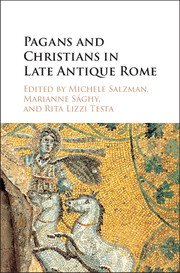 Pagans and Christians in Late Antique Rome
Pagans and Christians in Late Antique Rome Book contents
- Frontmatter
- Contents
- List of Illustrations
- Biographies of Authors
- Acknowledgments
- Introduction
- Part I SENATORIAL POLITICS AND RELIGIOUS CONFLICT
- Part II The Construction of New Religious Identities
- 4 Christians and the Invention of Paganism in the Late Roman Empire
- 5 Late Antique Divi and Imperial Priests of the Late Fourth and Early Fifth Centuries
- 6 Artis heu magicis : The Label of Magic in Fourth-Century Conflicts and Disputes
- 7 Crowd Behavior in Late Antique Rome
- Part III Pagans and Christians: Coexistence and Competition
- Section A Pagans and Religious Practices in Christian Rome
- Section B Death and the Afterlife
- Section C Reading Religious Iconography as Evidence for Pagan–Christian Relations
- Concluding Remarks: Vrbs Roma between Pagans and Christians
- Index
- References
7 - Crowd Behavior in Late Antique Rome
from Part II - The Construction of New Religious Identities
Published online by Cambridge University Press: 05 November 2015
- Frontmatter
- Contents
- List of Illustrations
- Biographies of Authors
- Acknowledgments
- Introduction
- Part I SENATORIAL POLITICS AND RELIGIOUS CONFLICT
- Part II The Construction of New Religious Identities
- 4 Christians and the Invention of Paganism in the Late Roman Empire
- 5 Late Antique Divi and Imperial Priests of the Late Fourth and Early Fifth Centuries
- 6 Artis heu magicis : The Label of Magic in Fourth-Century Conflicts and Disputes
- 7 Crowd Behavior in Late Antique Rome
- Part III Pagans and Christians: Coexistence and Competition
- Section A Pagans and Religious Practices in Christian Rome
- Section B Death and the Afterlife
- Section C Reading Religious Iconography as Evidence for Pagan–Christian Relations
- Concluding Remarks: Vrbs Roma between Pagans and Christians
- Index
- References
Summary
Crowds are everywhere. In all stratified societies, past and present, crowds have appeared, and continue to appear, especially in urban contexts where crowds’ emergence can be regarded as a prominent expression of public life. Crowd behavior is closely connected to many social, political, cultural, economic, and religious phenomena within urban contexts, and is of great interest to society's leadership. Indeed, crowd management and control is of great importance to all authorities who deal with the organized or spontaneous activities of large gatherings of people.
This contribution examines crowd behavior in late antique Rome. With a particular focus on Christianity and its influence on crowd behavior, I offer an analysis of ways modern methodology could be valuable for our understanding of crowd behavior in the late Roman world. To many modern scholars, the emergence of Christianity and its ability to become the sole religion of the Roman Empire and subsequent developments within the religious life of the inhabitants around the Mediterranean should be seen as one of the most important characteristics of late antiquity. That does not mean, however, that all institutions and societal phenomena in the Roman Empire were entirely submerged into and defined by Christianity as if the Roman world was Christianized in all its aspects. This chapter demonstrates how crowd behavior lends itself well for an analysis of an urban phenomenon in late antiquity that was, on one hand, affected by Christianity, but that, on the other hand, was unaffected by religion, and in many instances even transcended religious influence.
Most previous scholarship on crowd behavior in the Roman world has dealt with ancient crowds in a stereotypical way: it tended to focus on the Populus Romanus as a powerful representative of Rome's population that was kept satisfied by “bread and circuses.” Roman authorities were sensitive toward the sentiments of the Roman people because, if the people were disgruntled, riots might break out that endangered the city's or even the empire's stability. Such a view of the Roman people, and thus of crowd behavior in the Roman world, is mainly based on fear of aggression and riots. In other words, it focuses on situations of potential crisis and on a relationship between rulers and subjects that was based on their polarization.
- Type
- Chapter
- Information
- Pagans and Christians in Late Antique RomeConflict, Competition, and Coexistence in the Fourth Century, pp. 178 - 194Publisher: Cambridge University PressPrint publication year: 2015


